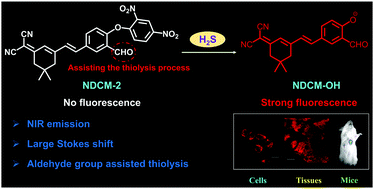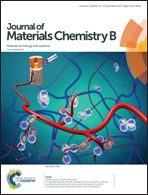A NIR fluorescent probe for the detection and visualization of hydrogen sulfide using the aldehyde group assisted thiolysis of dinitrophenyl ether strategy†
Abstract
In view of the significant physiological and pathological roles H2S plays in living systems, it is crucial to develop fluorescent probes for H2S detection with high sensitivity and good selectivity. Herein, a novel NIR fluorescent probe NDCM-2 based on the dicyanoisophorone derivative was designed and synthesized by employing ortho-aldehyde assisted thiolysis of 2,4-dinitrophenyl (DNP) ether as the sensing strategy to achieve highly specific H2S detection in living systems. The studies demonstrated that probe NDCM-2 exhibited excellent sensing performance toward H2S with 160-fold NIR fluorescence enhancement, a rapid response within 15 min, excellent sensitivity with a detection limit of 58.797 nM, a large Stokes shift of 170 nm and good selectivity. In light of these unique properties, NDCM-2 has been successfully applied for the fluorescence imaging of H2S in biological systems (living cells, tissues and mice), demonstrating that it would be an effective tool for H2S detection in living systems.



 Please wait while we load your content...
Please wait while we load your content...